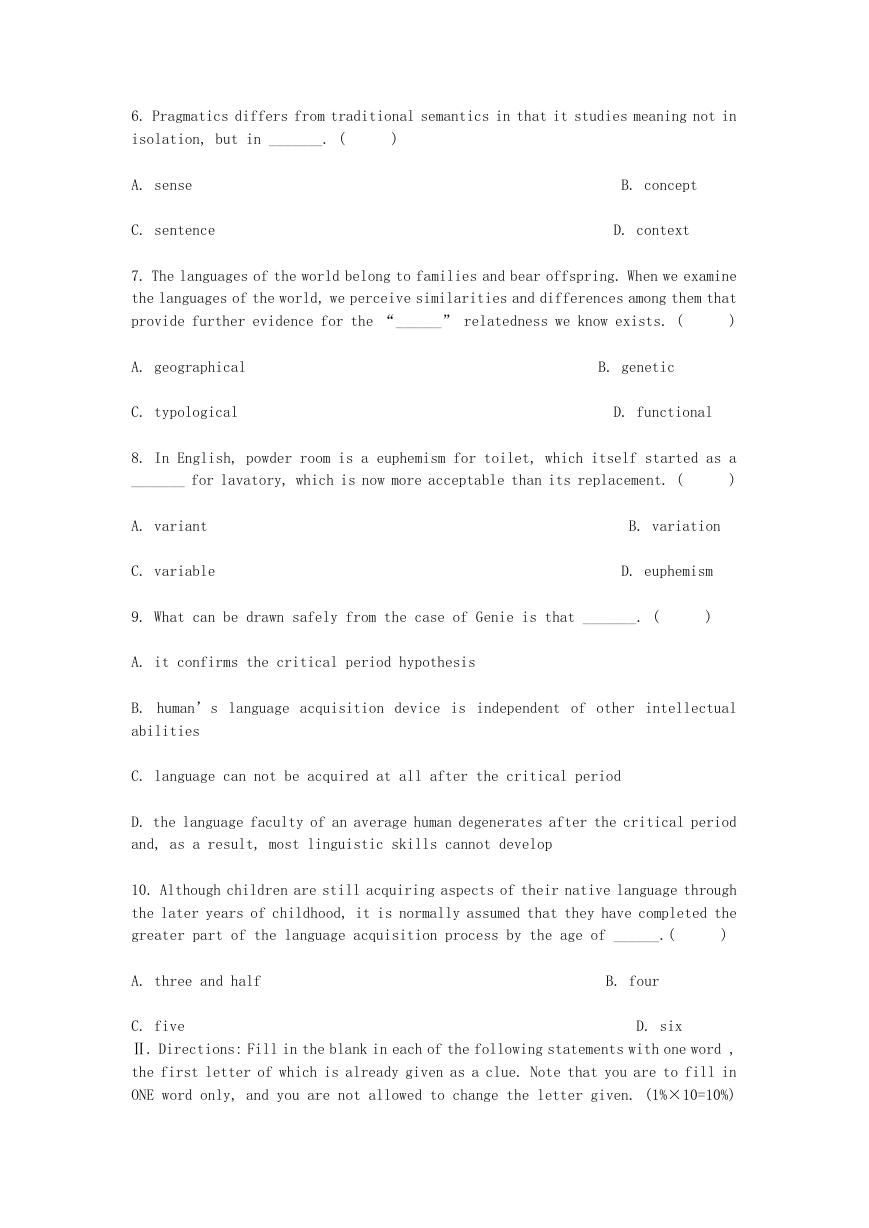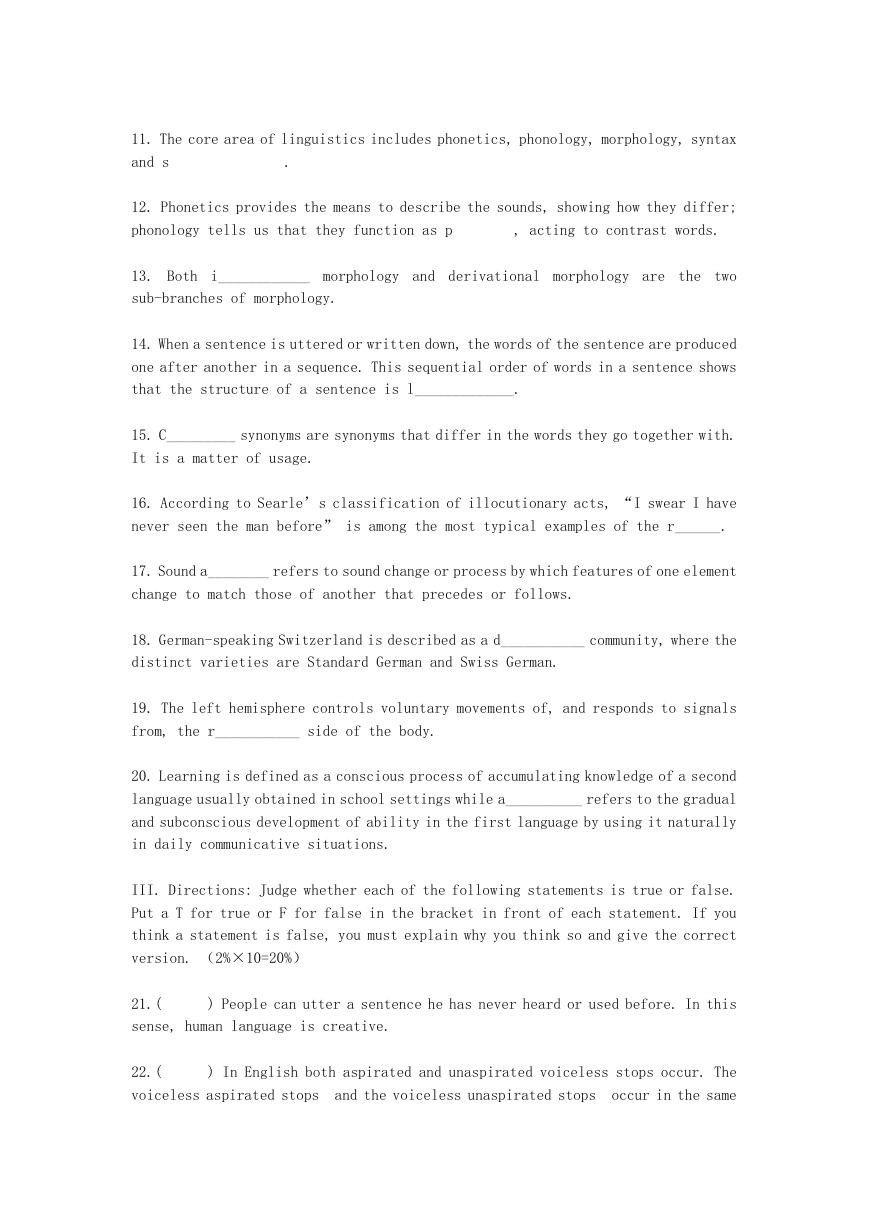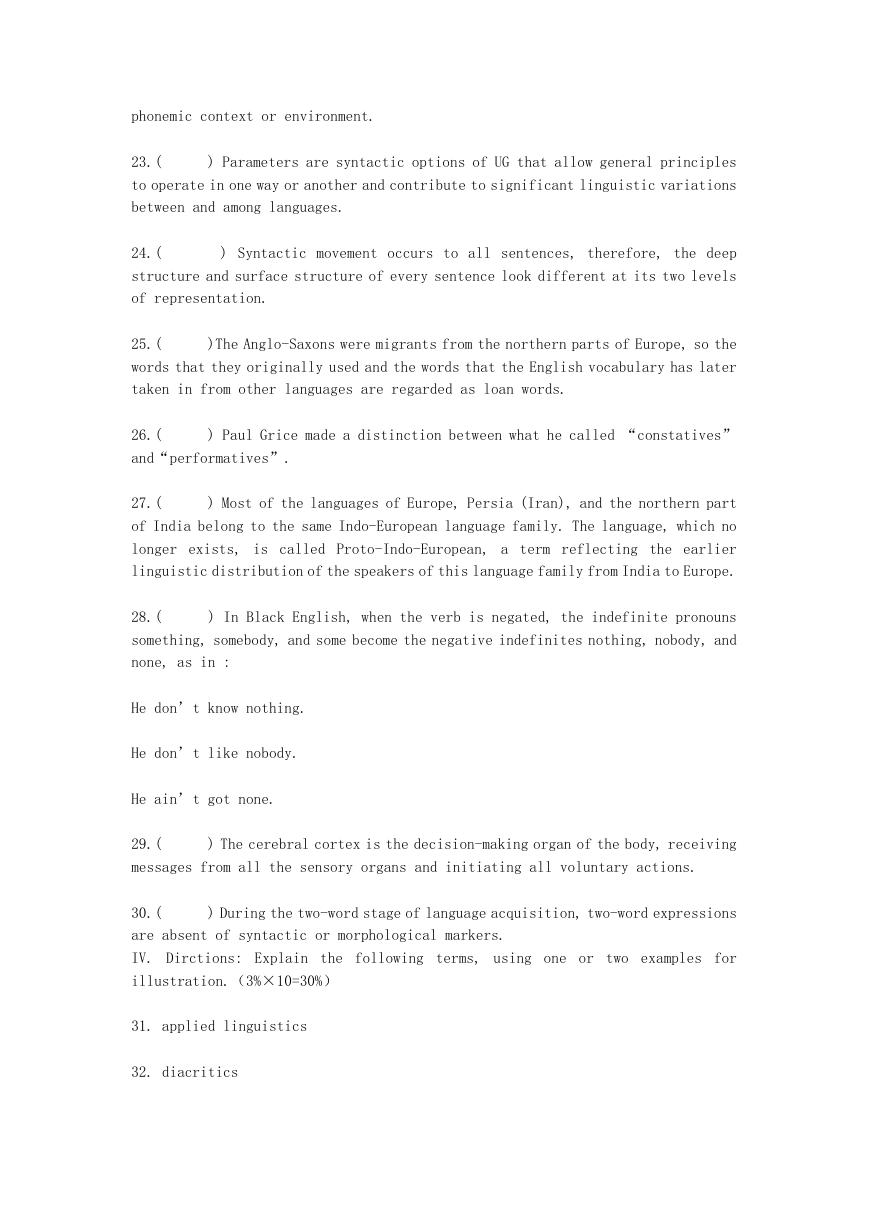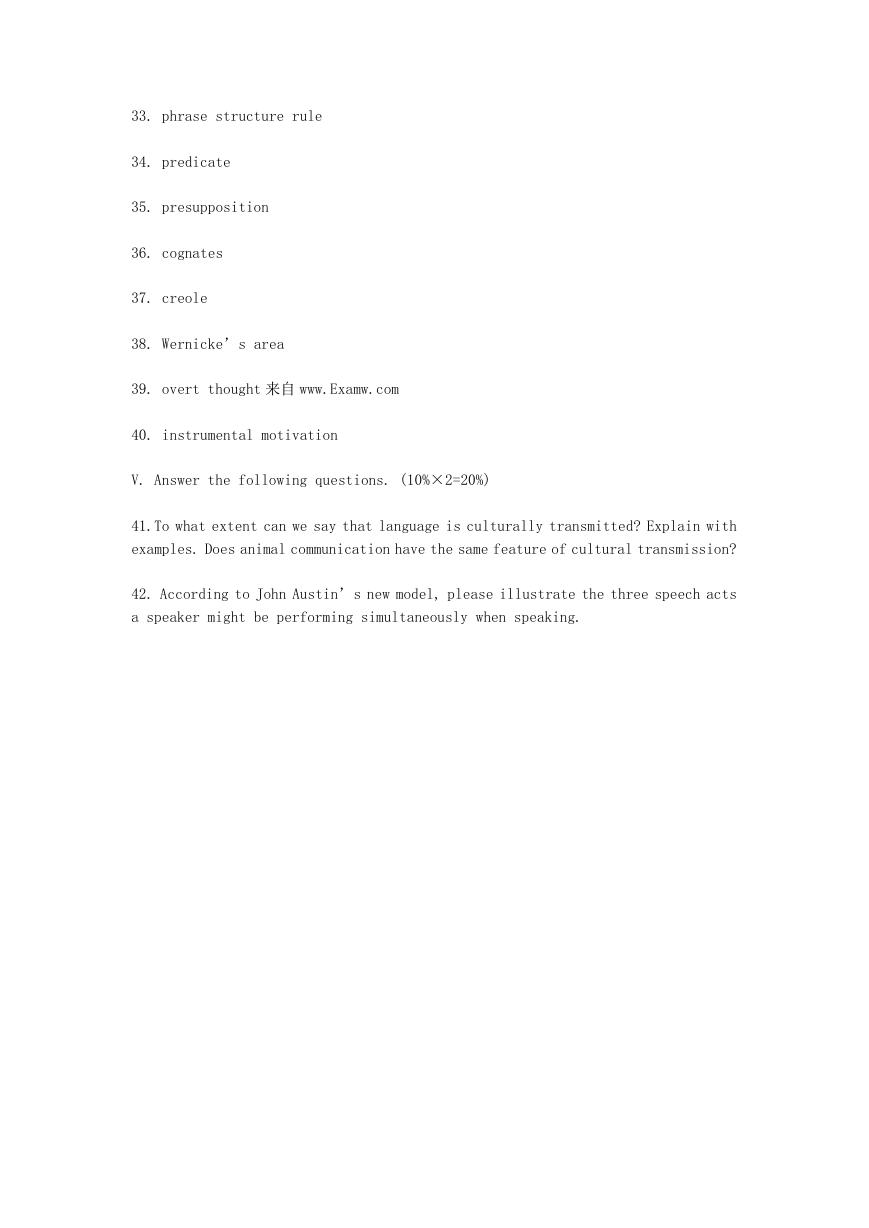2008 年 1 月全国高等教育自学考试现代语言学真题
I. Directions: Read each of the following statements carefully. Decide which one
of the four choices best completes the statement and put the letter A, B, C, or D
in the bracket.(2%×10=20%)
1. The phonetic form of the prefix meaning “not” is phonetically variant; it is
before a vowel or an alveolar consonant,
before a labial consonant, and before
a _____, for example, inoperable , indiscrete , impossible , and inconceivable .
(
)
A. velar
C. fricative
B. palatal
D. stop
2. Tones are pitch variations that refer to morphologically defined segments to the
extent that different _______ in a language are distinctive. Pitch variations can
distinguish meaning just like phonemes.(
)
A. sounds
C. pitches
B. patterns
D. features
3. Some of the ______ rules are productive; they can be used freely to form new
words.(
)
A. syntactic
C. semantic
B. morphological
D. phonological
4. VP, AP and PP share similar syntactic properties with NP in that they allow for
_______ and complements in phrases. (
)
A. heads
C. lexical items
words
B. specifiers
D. obligatory
5. Bloomfield drew on _______ psychology when trying to define the meaning of
linguistic forms. (
)
A. contextual
C. behaviorist
B. conceptualist
D. mentalist
�
6. Pragmatics differs from traditional semantics in that it studies meaning not in
isolation, but in _______. (
)
A. sense
C. sentence
B. concept
D. context
7. The languages of the world belong to families and bear offspring. When we examine
the languages of the world, we perceive similarities and differences among them that
provide further evidence for the “______” relatedness we know exists. (
)
A. geographical
C. typological
B. genetic
D. functional
8. In English, powder room is a euphemism for toilet, which itself started as a
_______ for lavatory, which is now more acceptable than its replacement. (
)
A. variant
C. variable
B. variation
D. euphemism
9. What can be drawn safely from the case of Genie is that _______. (
)
A. it confirms the critical period hypothesis
B. human’s language acquisition device is independent of other intellectual
abilities
C. language can not be acquired at all after the critical period
D. the language faculty of an average human degenerates after the critical period
and, as a result, most linguistic skills cannot develop
10. Although children are still acquiring aspects of their native language through
the later years of childhood, it is normally assumed that they have completed the
greater part of the language acquisition process by the age of ______.(
)
A. three and half
B. four
C. five
Ⅱ. Directions: Fill in the blank in each of the following statements with one word ,
the first letter of which is already given as a clue. Note that you are to fill in
ONE word only, and you are not allowed to change the letter given. (1%×10=10%)
D. six
�
11. The core area of linguistics includes phonetics, phonology, morphology, syntax
and s
.
12. Phonetics provides the means to describe the sounds, showing how they differ;
phonology tells us that they function as p
, acting to contrast words.
13. Both i____________ morphology and derivational morphology are the two
sub-branches of morphology.
14. When a sentence is uttered or written down, the words of the sentence are produced
one after another in a sequence. This sequential order of words in a sentence shows
that the structure of a sentence is l_____________.
15. C_________ synonyms are synonyms that differ in the words they go together with.
It is a matter of usage.
16. According to Searle’s classification of illocutionary acts, “I swear I have
never seen the man before” is among the most typical examples of the r______.
17. Sound a________ refers to sound change or process by which features of one element
change to match those of another that precedes or follows.
18. German-speaking Switzerland is described as a d___________ community, where the
distinct varieties are Standard German and Swiss German.
19. The left hemisphere controls voluntary movements of, and responds to signals
from, the r___________ side of the body.
20. Learning is defined as a conscious process of accumulating knowledge of a second
language usually obtained in school settings while a__________ refers to the gradual
and subconscious development of ability in the first language by using it naturally
in daily communicative situations.
III. Directions: Judge whether each of the following statements is true or false.
Put a T for true or F for false in the bracket in front of each statement. If you
think a statement is false, you must explain why you think so and give the correct
version. (2%×10=20%)
21.(
sense, human language is creative.
) People can utter a sentence he has never heard or used before. In this
22.(
voiceless aspirated stops
) In English both aspirated and unaspirated voiceless stops occur. The
occur in the same
and the voiceless unaspirated stops
�
phonemic context or environment.
23.(
) Parameters are syntactic options of UG that allow general principles
to operate in one way or another and contribute to significant linguistic variations
between and among languages.
) Syntactic movement occurs to all sentences, therefore, the deep
24.(
structure and surface structure of every sentence look different at its two levels
of representation.
25.(
)The Anglo-Saxons were migrants from the northern parts of Europe, so the
words that they originally used and the words that the English vocabulary has later
taken in from other languages are regarded as loan words.
26.(
and“performatives”.
) Paul Grice made a distinction between what he called “constatives”
27.(
) Most of the languages of Europe, Persia (Iran), and the northern part
of India belong to the same Indo-European language family. The language, which no
longer exists, is called Proto-Indo-European, a term reflecting the earlier
linguistic distribution of the speakers of this language family from India to Europe.
) In Black English, when the verb is negated, the indefinite pronouns
28.(
something, somebody, and some become the negative indefinites nothing, nobody, and
none, as in :
He don’t know nothing.
He don’t like nobody.
He ain’t got none.
29.(
messages from all the sensory organs and initiating all voluntary actions.
) The cerebral cortex is the decision-making organ of the body, receiving
) During the two-word stage of language acquisition, two-word expressions
30.(
are absent of syntactic or morphological markers.
IV. Dirctions: Explain the following terms, using one or two examples for
illustration.(3%×10=30%)
31. applied linguistics
32. diacritics
�
33. phrase structure rule
34. predicate
35. presupposition
36. cognates
37. creole
38. Wernicke’s area
39. overt thought 来自 www.Examw.com
40. instrumental motivation
V. Answer the following questions. (10%×2=20%)
41.To what extent can we say that language is culturally transmitted? Explain with
examples. Does animal communication have the same feature of cultural transmission?
42. According to John Austin’s new model, please illustrate the three speech acts
a speaker might be performing simultaneously when speaking.
�










 2023年江西萍乡中考道德与法治真题及答案.doc
2023年江西萍乡中考道德与法治真题及答案.doc 2012年重庆南川中考生物真题及答案.doc
2012年重庆南川中考生物真题及答案.doc 2013年江西师范大学地理学综合及文艺理论基础考研真题.doc
2013年江西师范大学地理学综合及文艺理论基础考研真题.doc 2020年四川甘孜小升初语文真题及答案I卷.doc
2020年四川甘孜小升初语文真题及答案I卷.doc 2020年注册岩土工程师专业基础考试真题及答案.doc
2020年注册岩土工程师专业基础考试真题及答案.doc 2023-2024学年福建省厦门市九年级上学期数学月考试题及答案.doc
2023-2024学年福建省厦门市九年级上学期数学月考试题及答案.doc 2021-2022学年辽宁省沈阳市大东区九年级上学期语文期末试题及答案.doc
2021-2022学年辽宁省沈阳市大东区九年级上学期语文期末试题及答案.doc 2022-2023学年北京东城区初三第一学期物理期末试卷及答案.doc
2022-2023学年北京东城区初三第一学期物理期末试卷及答案.doc 2018上半年江西教师资格初中地理学科知识与教学能力真题及答案.doc
2018上半年江西教师资格初中地理学科知识与教学能力真题及答案.doc 2012年河北国家公务员申论考试真题及答案-省级.doc
2012年河北国家公务员申论考试真题及答案-省级.doc 2020-2021学年江苏省扬州市江都区邵樊片九年级上学期数学第一次质量检测试题及答案.doc
2020-2021学年江苏省扬州市江都区邵樊片九年级上学期数学第一次质量检测试题及答案.doc 2022下半年黑龙江教师资格证中学综合素质真题及答案.doc
2022下半年黑龙江教师资格证中学综合素质真题及答案.doc